How I Protect My Butcher Block Countertops
How I Protect My Butcher Block Counter Tops | Here I tell you why I would use wood countertops ten times over and show you how easy they are to maintain.
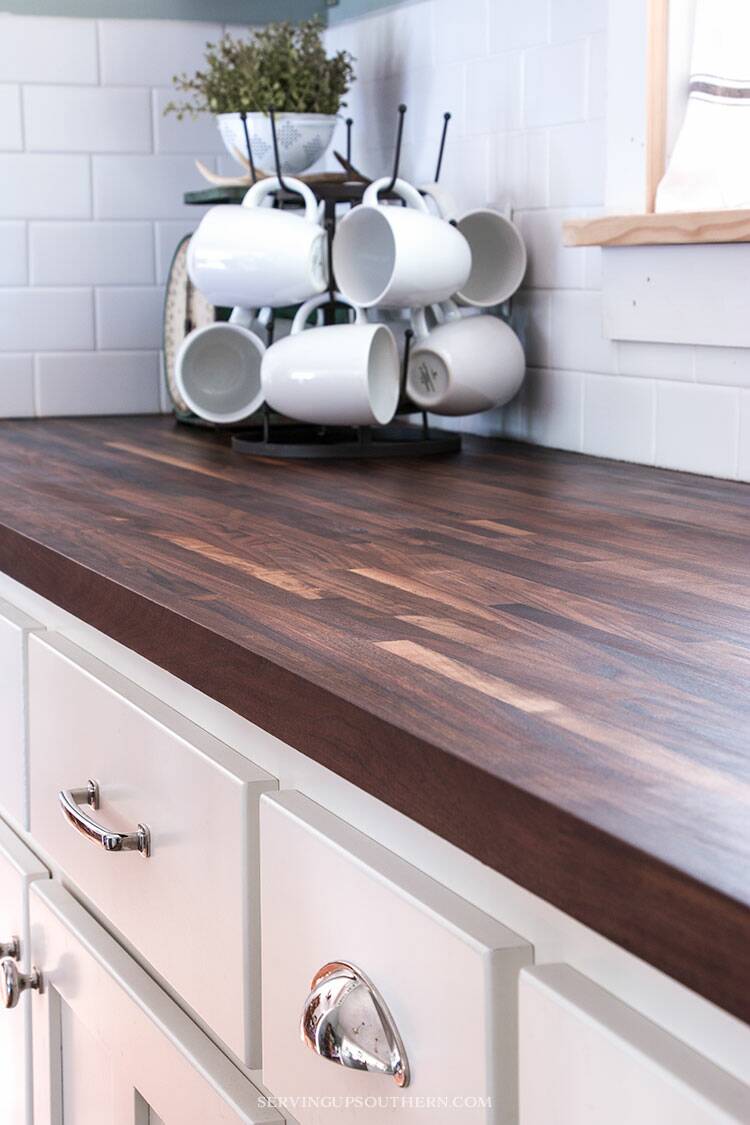
I want to share how I protect my butcher block countertops with you since that is the first thing people ask when they see them. Another question I get is, would I do them again, and my answer is a thousand times – YES! I LOVE my wood countertops. I might not have if I had not done extensive research and discovered this method. The last thing I want or need is something that requires high maintenance to maintain.
After doing a lot of looking and inquiring about different countertops we decided on the American Walnut countertops from Lumber Liquidators. I loved that it was a natural dark wood that wouldn’t require staining.
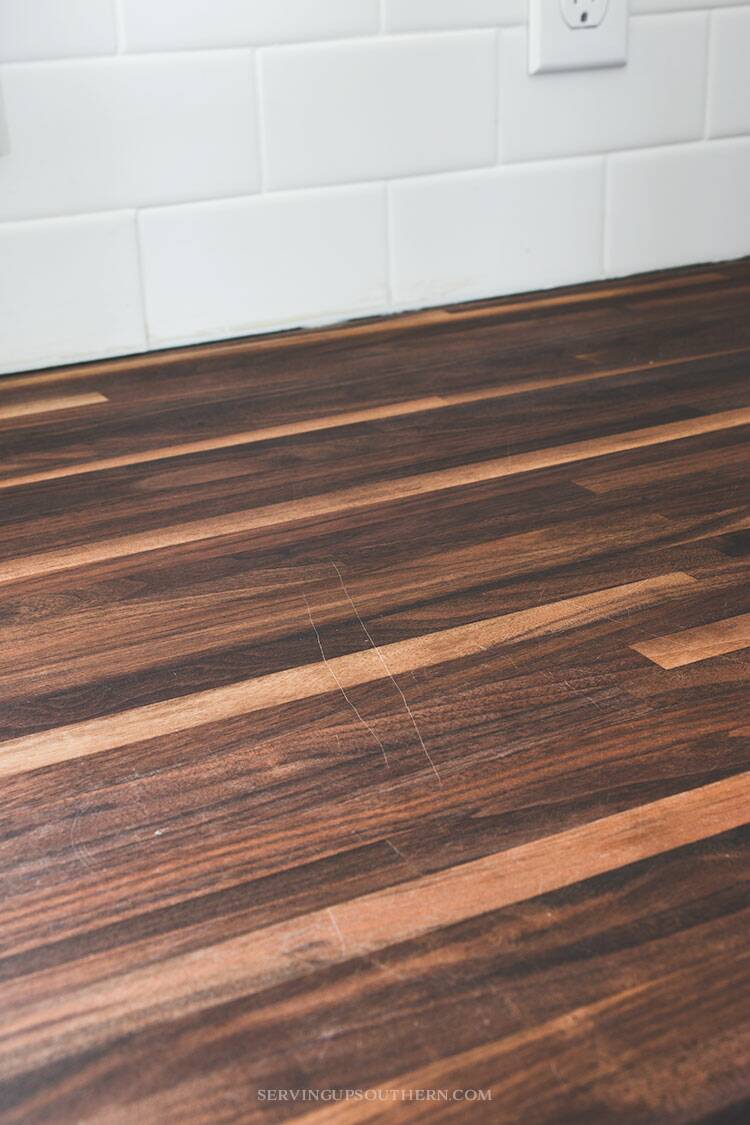
I’ll start by saying, scuffing happens when you have wood countertops. It has always been very superficial scuffs though. The two not so superficial scratches you see in the image here are scratches Pete made so that we can show you how easy this is to fix. Usually, we wipe the surface down with my very favorite countertop product, and those little superficial scuffs disappear like magic. Since dear hubby decided to scratch things up a bit, we needed to do some sanding. So, this will show you how to not only maintain but repair the tops should the need arise.

Using a 150 grit sandpaper, Pete sanded the countertops down. It didn’t take much – just a light sanding was all he did. Side note -we had recently removed the caulking that our tile guy had used. The caulking had yellowed pretty bad over the last two years, and we weren’t happy with it. We (as in he) will be re-caulking everything soon.
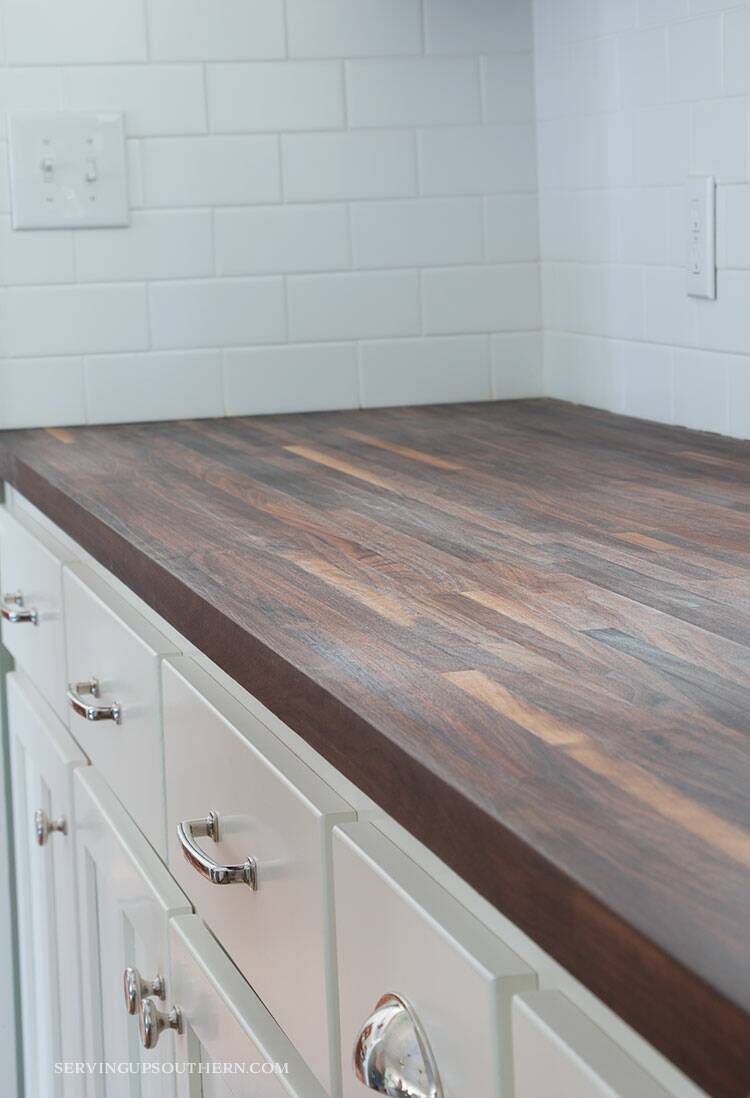
He just went ahead and sanded both sections of the countertops since removing the caulking left a couple of little scratches here and there around the outer edges. When sanding your wood to prepare for the curing process, you don’t want to go too fine with the grit of your sandpaper – 150 grit is about it.
Why only 150 grit?
The reason for this is because the finer you sand the wood, the more those tiny sanded particles close the pores of the wood, causing it to get a “polished” finish. This can limit the penetration of the product during the curing process. The more course the surface is the more penetration you will have. When the sanding was all done, we were all ready for the next step.
How I Protect My Butcher Block Countertops
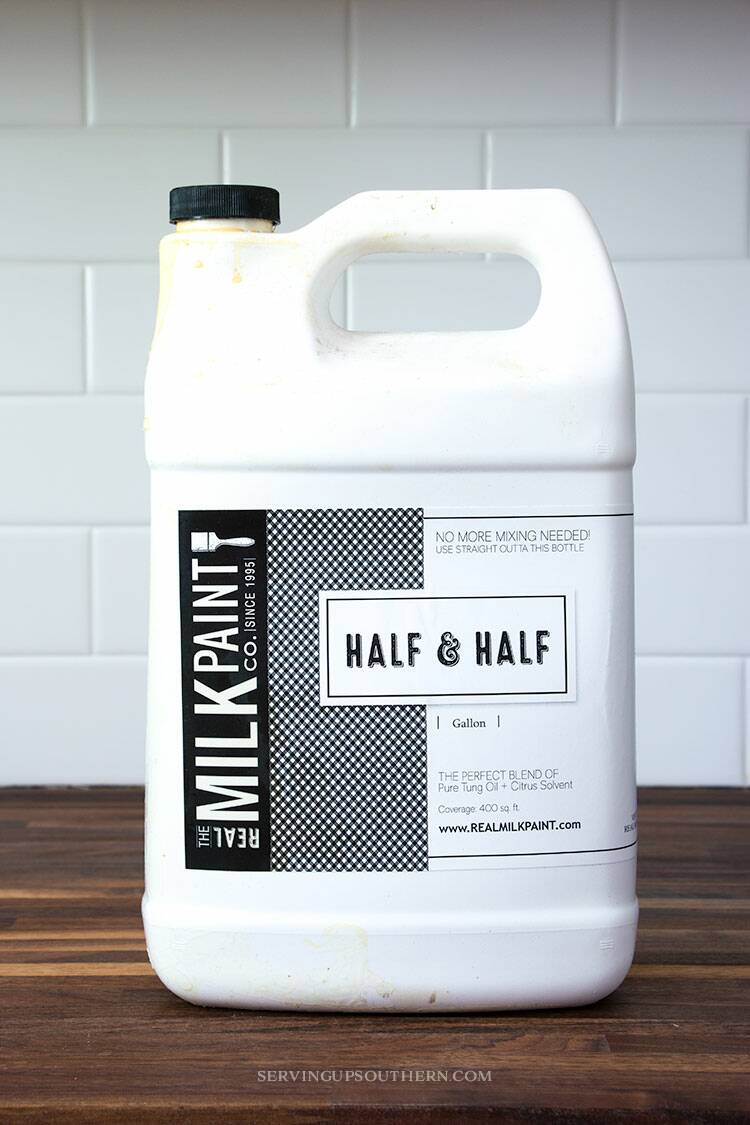
Let me introduce you to Half & Half made by The Real Milk Paint C0. (not an affiliate link) Let me tell you, this stuff is amazing! If you are thinking about wood countertops, this is your product. I decided to get on the phone with the company today and ask some questions to make sure I am giving you the most accurate information I can. The thing I love most about calling them is that a real live person always answers the phone.
Who do I talk to at RMPC?
Most often, the first friendly voice you hear is Tonya. She is very helpful and knowledgeable about the products, but if she has any doubts, she will quickly get you to someone who knows the answers to your questions. I cannot emphasize enough how excellent their customer service is, and I must say I put them to the test. I can’t tell you how many times I called this company and talked with the owner (poor guy) about the curing process. They also have great online videos explaining the method in detail.
Citrus and pine formulas
What I have is pure tung oil blended with citrus solvent – Half & Half. However, due to a global shortage of pure citrus solvent (they use the oil from the orange peels) and the price increase because of this shortage, the company has made a few changes. The RMPC is all about being eco-friendly, so they found another natural organic component to replace the citrus solvent, and that is pine. You can still buy their pure citrus solvent, but they tell me that could change any day. The availability could come to an end. This unfortunate circumstance is due to inclement weather and bugs taking a toll on the citrus groves. UPDATE: This citrus formula is in stock again.
Why do they mix this formula?
You may be wondering why they mix the formula in a 1:1 ratio. The reason is pure tung oil is extremely thick. It compares to the same thickness as honey. If you put just tung oil on your wood surface, it would only sit there with minimal absorption. (Think of how a drop of honey will just sit until you wipe it up.) The citrus or pine solvent is added as an organic thinner to thin the tung oil allowing it to penetrate the wood. Once the Half & Half is applied, the solvent eventually evaporates. The solvent’s only role in this process is to thin. Once it evaporates, you are left with pure tung oil.
You can learn more about how to do your first-time cure here at The Real Milk Paint Co. (not an affiliate link). We followed the recommended curing process EXACTLY the way they recommend. It is a little lengthy, but if you hang in there, it will be worth it. I promise!
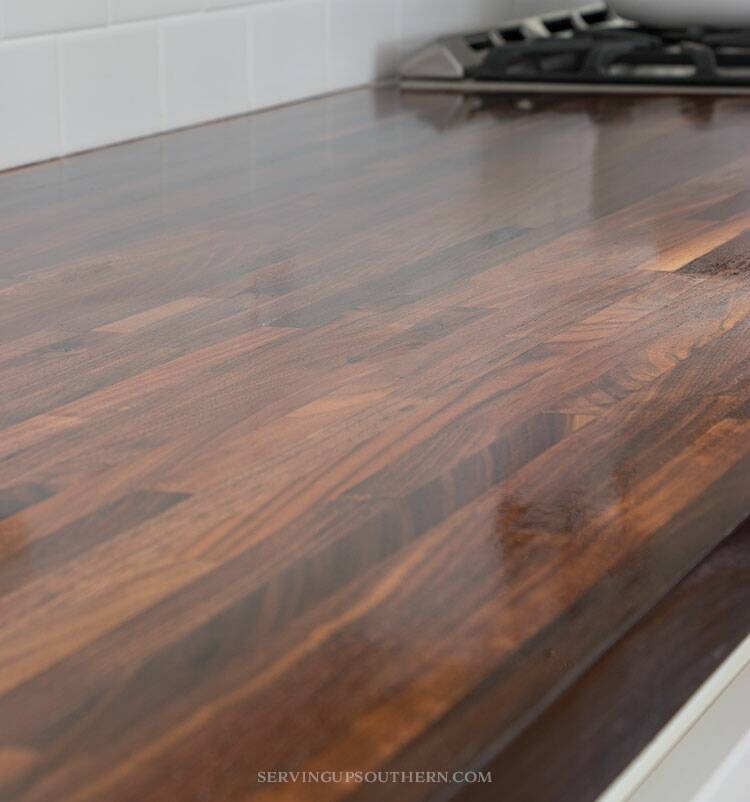
You can use a sponge or a rag to apply the oil. We like to use these paint sponge brushes from Amazon. Just pour a little on the countertops and brush it around with the sponge brush. Repeat in different areas until the entire surface is covered. Remember, we did the whole countertop surface to show you how this process is done. Typically, we would have only done a touch-up here and there.
What RMPC recommends for touch-ups
When touching up a small area, the RMPC recommends using a 2:1 ratio instead of a half & half (1:1). The reason for this is because if the curing process is done correctly (just as they recommend) the pores of the wood will be saturated. To get as much penetration from the tung oil as possible, you want to dilute it, even more, to ensure that it gets down into any open surface area it can penetrate for full absorption.
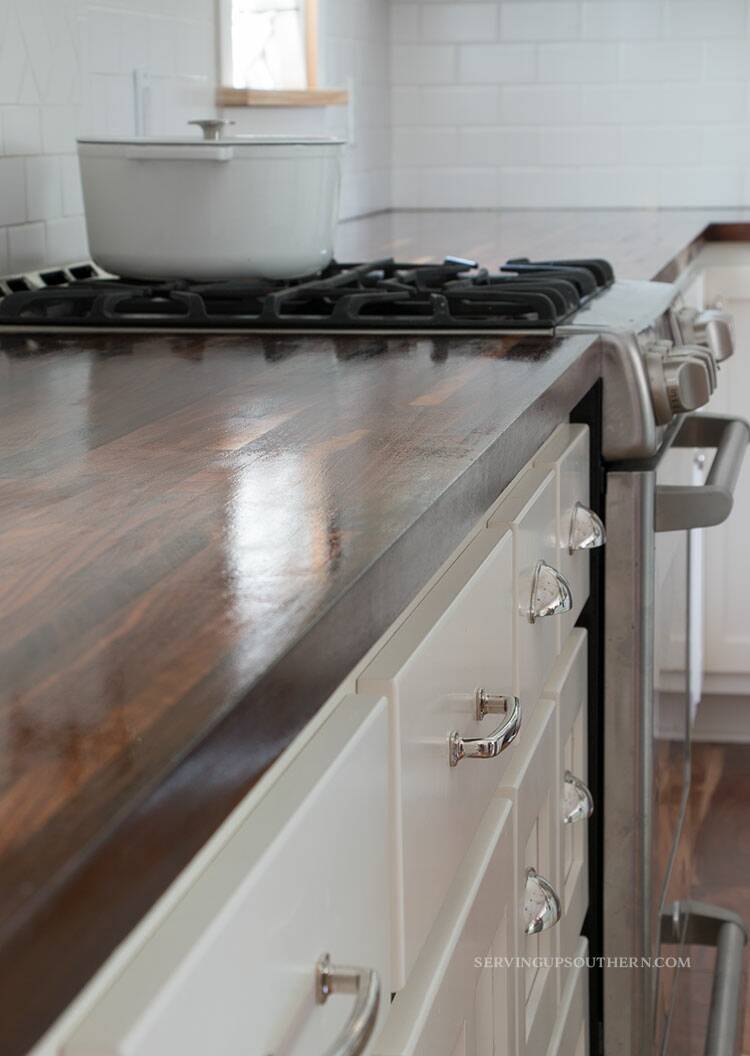
We allowed the tung oil to soak in overnight. I took this picture the following morning, and you can see that quite a bit of oil is still on the surface. Using a soft cotton rag, I wiped the residue away. I was quite surprised at how much I ended up wiping off. The leftover residue lets us know that the wood was fully saturated. Due to the pores being “full,” it was unable to absorb all of the oil we applied. Your goal is to have all of the tung oil absorbed into the wood and not have any on the surface. It’s important to wipe off anything that hasn’t soaked in.
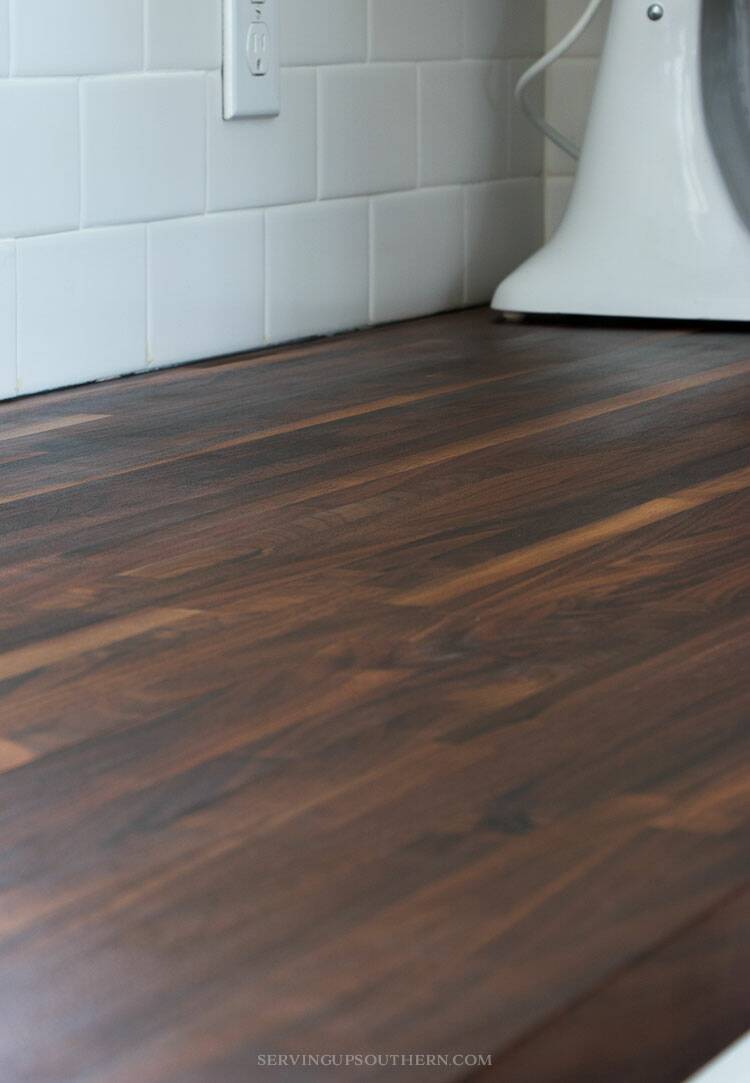
Remember those two scatches? Yep, they are long gone, and this is what I love about these countertops. With the help of the Half & Half, they are so easy to maintain and touch up. Since the highest grit sandpaper we used was 150 grit and the tung oil was able to get down into the open pores, we were left with rich dark countertops which is precisely what I was hoping for. If we had used a higher grit, we wouldn’t have gotten the darker color we wanted. Once they are cured, the product creates a food-safe surface, which was very important to me.
I knew I didn’t want to use polyurethane. I read the woes of other bloggers who had gone that route and were unhappy. Waterlox wasn’t an option due to it not being food-safe, and it would make them glossy. (Glossy is definitely not what I want.) Many food-based oils can turn rancid, resulting in an unpleasant odor and stickiness.
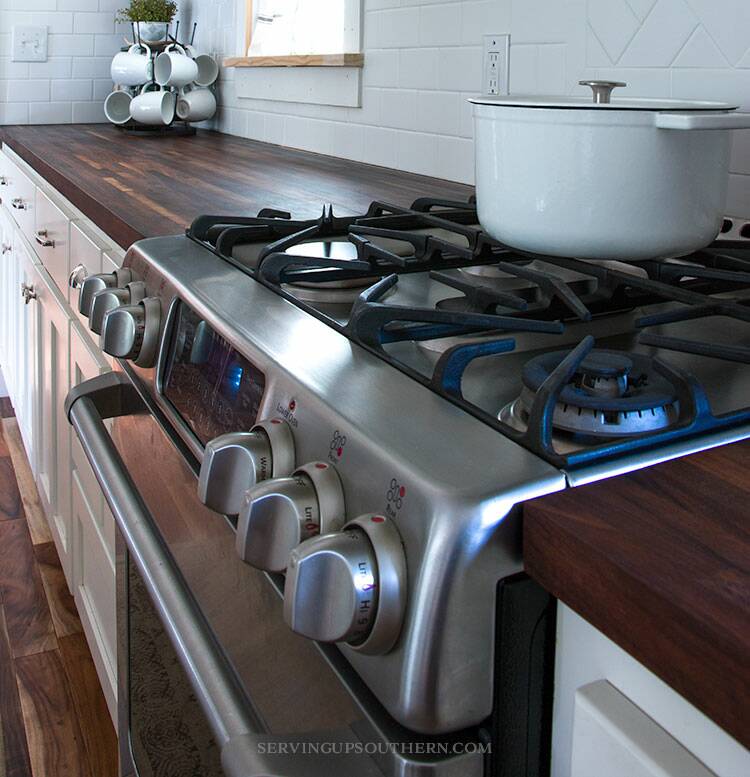
The tung oil gives my wood countertops a beautiful low-luster sheen that I absolutely love.
By the way, I cook here all the time. I boil, fry, saute, etc. Any grease or water splatters sit on top of the surface until it gets wiped up. The other day I was wiping up barbeque sauce that I overlooked from two nights prior. All I had to do was make my dishrag a little wetter and wipe it until it was all wiped up. In two years, I have never had any food or grease stains whatsoever.
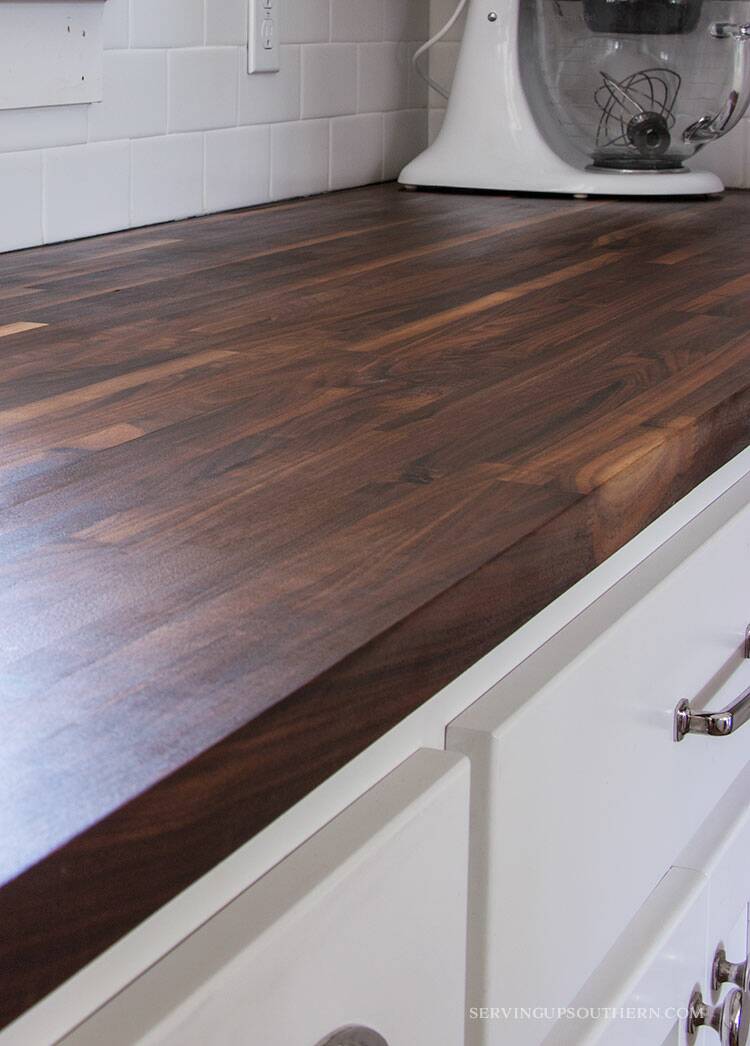
This section is the most used area of the countertops, and as you can see, it is flawless. We are careful – but not psycho careful. We always use cutting boards, and we never set any hot dishes or pans on the wood countertops. Hot items are placed on the stainless steel island top. More on that later. :)
That’s my secret
So, now you know how I protect my butcher block countertops. If wood countertops are something you’ve been sitting on the fence about, I hope this info helps you in your decision. I know they may not be for everyone. I also know that many of you love the way they look but may be a little gun-shy about getting them. I’m here to tell you that this product is a game-changer, and I have no regrets.
I would love to know what you’re thinking. Please leave your thoughts or any questions you might have in the comments below.
You might also like >>>
How To Hide A TV (In A Bookcase) With A Drop Cloth Curtain
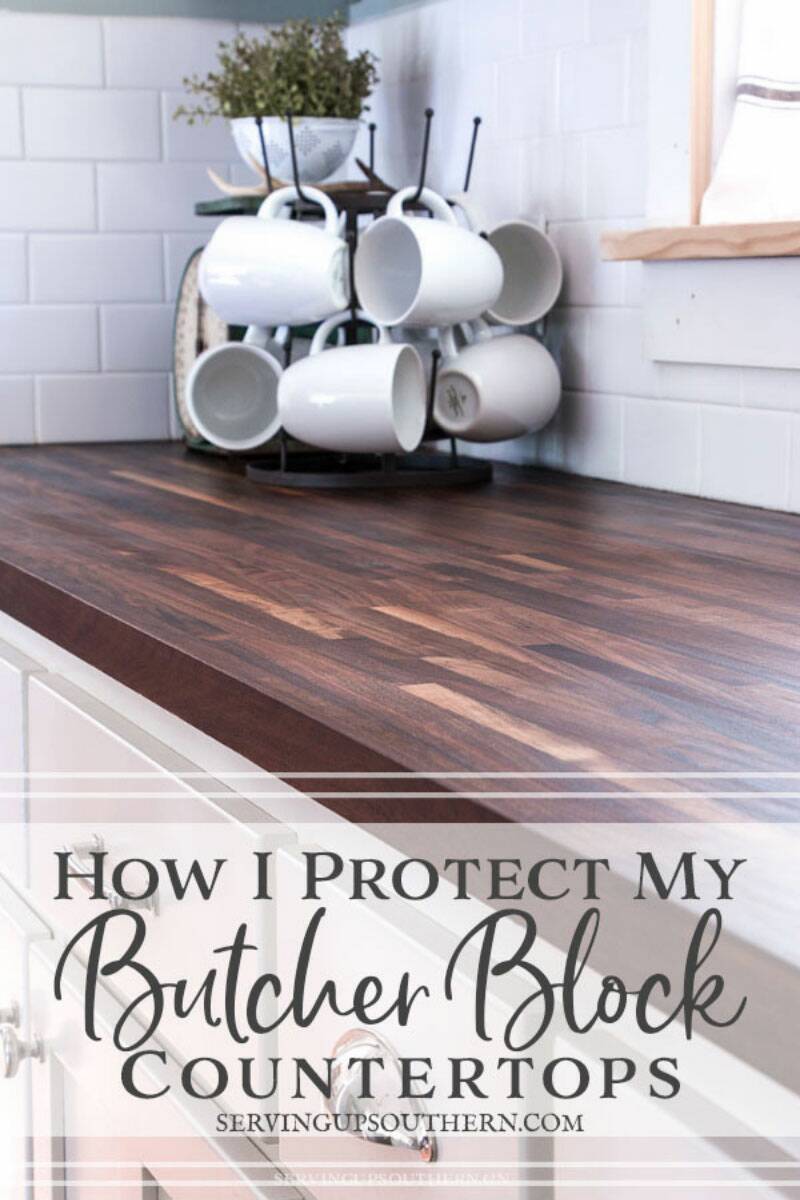

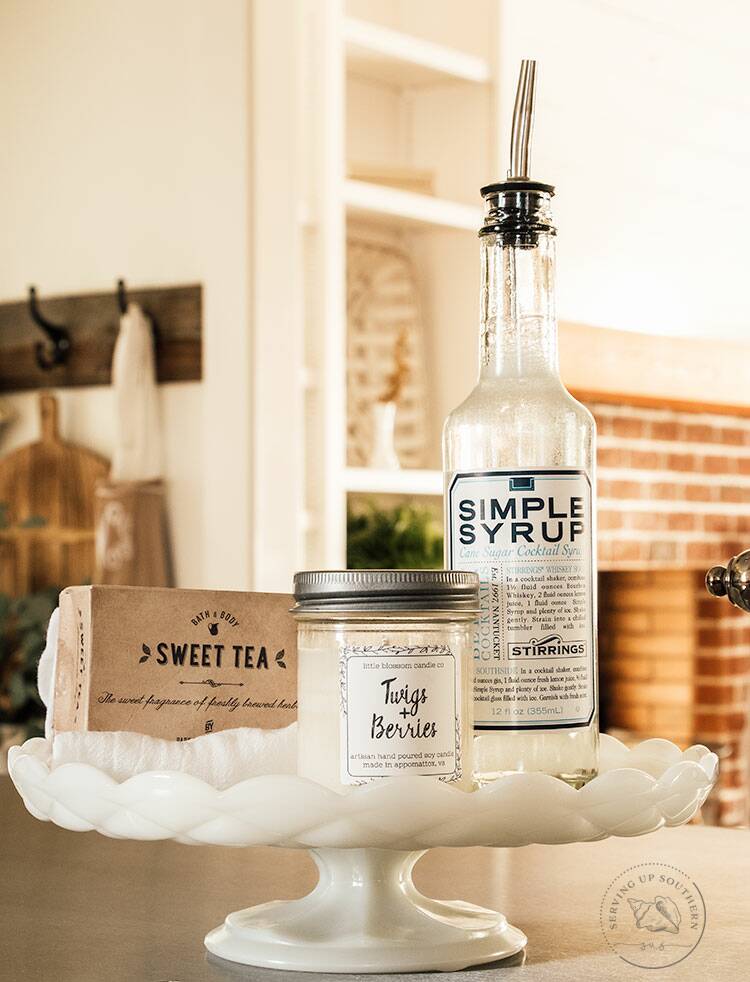
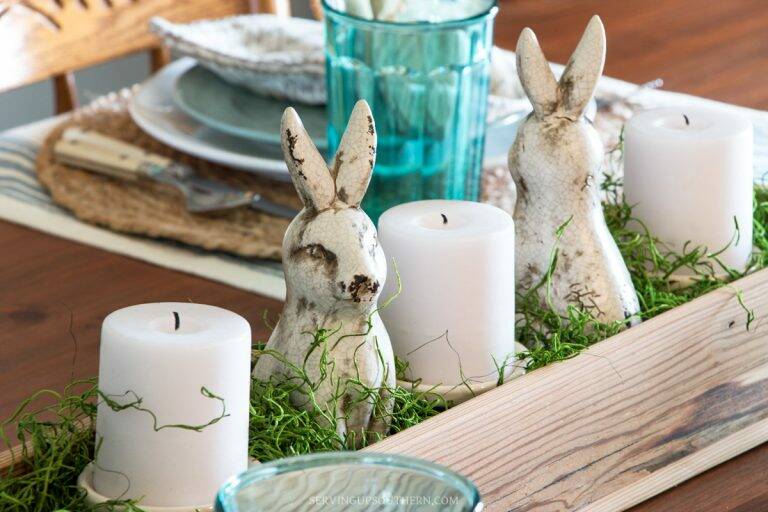
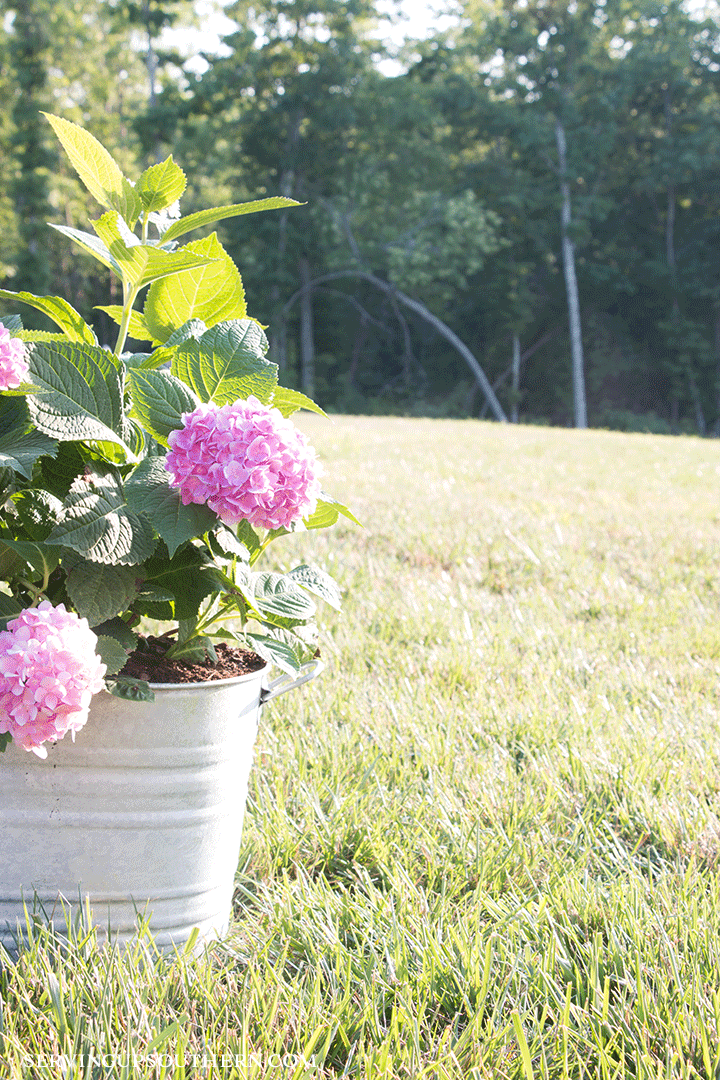
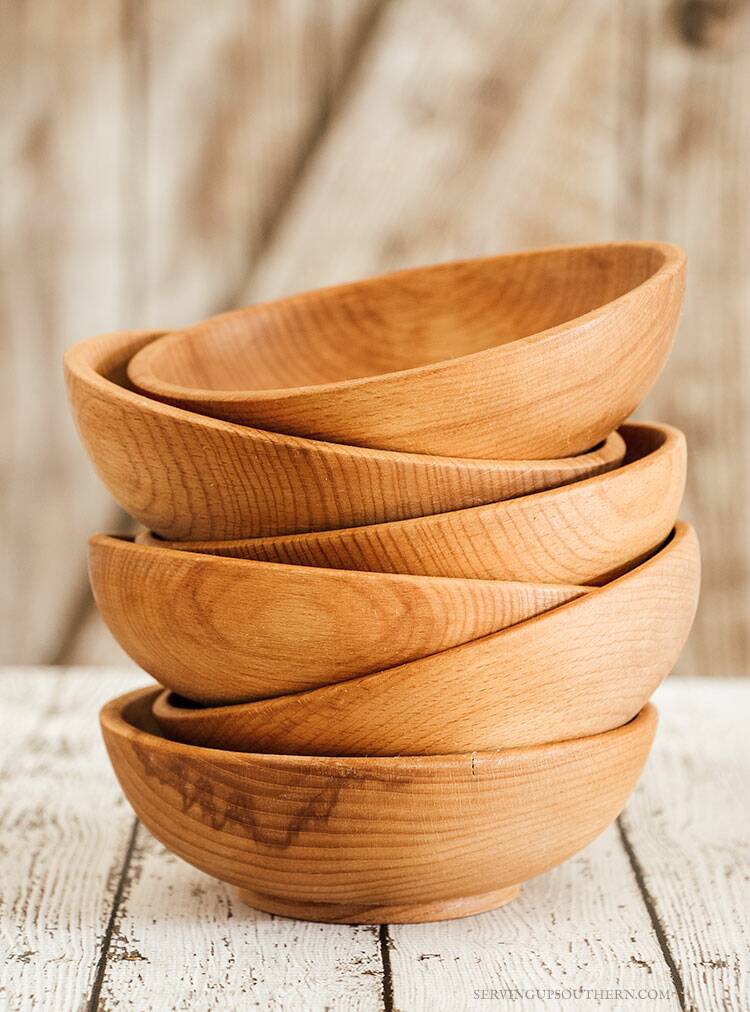

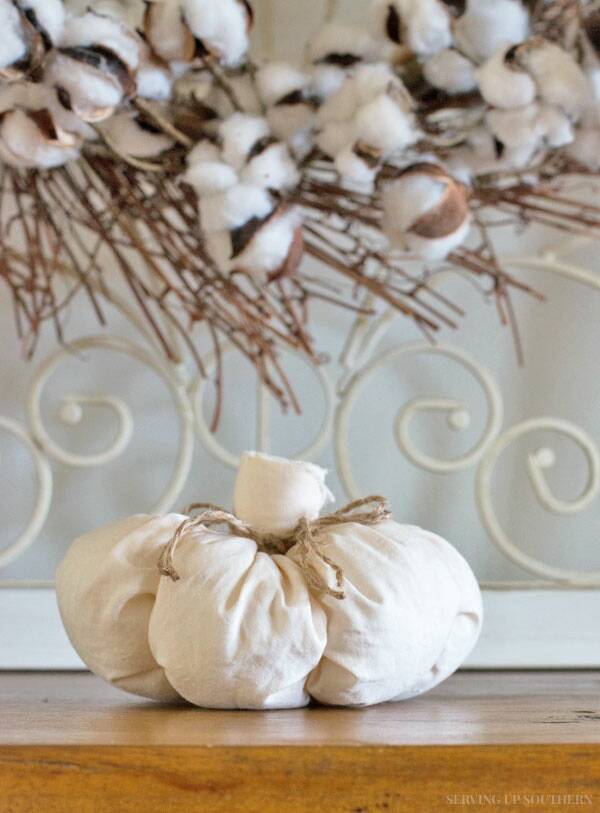

Wow! This is so informative! Your countertops are beautiful, and I love the look with the white cabinets.
Thank you, Joyce!
Thank you for the info! I just had the American Walnut installed. Mine are not as dark as yours but I want your exact color! Will the Half and Half darken the countertops a few shades? I noticed that you said you picked something that you wouldn’t need to stain.
Hi Kristen!
The countertops did darken with the Half and Half. You are right, I did not stain anything, and we used the clear Half and Half. As the product soaks into the wood, the countertops will darken and richen the various wood tones. I LOVE them! Please let me know how they turn out. If you have any other questions, feel free to ask.
>>> Kim
Thank you so much!!! Getting ready to treat them today!! So glad I came across your post!
Yay!
I know you’re going to love them! Please come back and let me know how things went.
>>> Kim
Hi Kim! I just ran into your post while looking up backsplashes for butcher block countertops. We built a home 2 years ago. I too chose butcher block, I chose acacia wood from lumber liquidators. They are beautiful! I too researched how to care for them before purchasing. I knew I didn’t want to use varnish, I ran across a recipe using bees wax and mineral oil. I never ran across the half and half you speak of. The bees wax and mineral oil concoction is food safe and easy to use. I melted the bees wax and mineral oil together in a mason jar, then continued to stir as it cooled to make a waxy substance, kind of like car wax. then I rub it into the counter… that’s it! They are beautiful! I too use cutting boards to protect my countertops. My husband is bad at spilling things on them and forgetting to wipe it up. Two years later they are still beautiful. I have not yet put a backsplash up, that’s my next job :) Thank you Kim for the info!
Lisa
Great tutorial! Lovely cabinets and counters!
Your post inspired me to use Half & Half on my butcher block island. Now I am thinking about the rest of my counters. How has Half & Half stand up around the sink. If possible, could you please tell me your normal maintenance routine. It you touch up around the sink, do you need to do that more often? I’m in love with butcher block, but my husband thinks it will be a big mistake around the sink. I also have a corner sink. Thank so much.
Your kitchen is lovely! Will you share more pics of it or direct me to where I can find more images? Found your site by searching dark stained butcher block counter tops :) in the middle of a full remodel on a house we bought and looking for inspiration!
Hi, Kat!
Thank you! I will eventually be sharing more on my kitchen. I’m not sure when yet, but it is in the plans. Good luck with your remodeling project!
>>> Kim
Hello, thank you for the wonderful info. Very informative. Quick question, To get your counters so nice and rick dark did you use just the “Half and Half” from the RMPC or the “ Half Dark”? We want our counter a nice rich dark color like you have. Thank you again.
Gina Hall
Hi, Gina!
We used the Half and Half. That darkened them enough for me. I wanted something that just enhanced what was there and would bring out a rich luster in the wood. I hope this helps!
>>> Kim
Your counters are just what I want. I just looked up Waterlox and it says it is tung oil and food safe. Is it possible that they changed their formula?
Hi Tina!
I guess anything is possible and maybe their product is now food safe. I know it wasn’t being advertised that way some time ago, but I did see where they are now saying it’s food safe once it’s dry. Waterlox has a product that is a tung oil finish. That word “finish” at the end means there is another additive besides tung oil. It is not 100% pure tung oil, so there will be a big difference between the two products. I recommend you do lots of homework before deciding which one is the best choice for you. Good luck!
>>> Kim
I have an Ikea butcher block island with the kitchen sink in it and I have previously used mineral oil. Can I use the Half & Half made by The Real Milk Paint C0 product, it has been about 4-5 months since I last applied mineral oil
Hi Connie!
I’m not sure, but I do know that the customer service at TRMPC is terrific! I do have another project going on, and I recently called them to ask if I could stain something and still use Half & Half. They told me as long as I used a water-based stain, it would be fine. They proceeded to tell me that an oil stain would clog the pores of the wood, which would interfere with the wood absorbing the Half & Half. It would be worth giving them a call and asking! Good luck with it! Thanks for stopping by!
Hello! Would you explain how you maintain your counters? Meaning, it’s been a year since this post, have you reapplied at all? Or, have you done the whole process again?
Hi Lisa!
The steps I talk about above is how we maintain the countertops. We have not reapplied since this post, but when we are ready, the process will be the same each time minus the repair on the scratches since Pete did those for the sole purpose of this post. I hope this helps!
>>> Kim
I am so thankful for your informative post! You inspired me to pull the trigger on installing a new peninsula with 3” walnut butcher block countertop and use the RMPC 50/50 product. Just installed with initial treatment on Monday. I absolutely love it. It turned out so beautiful and the 50/50 was so easy to use (and still available with the citrus solvent vs. pine). Open windows and fans for a couple of days and the residual citrus smell is rather pleasant! Thank you again for doing all your research and sharing!
Hi Lisa!
You are SO welcome! I LOVE hearing that my sharing about my countertops inspired you to pull the trigger! I was delighted when I saw that the citrus solvent was back on the website again! (I know the orange growers are happy about that too!) And yes, the citrus smell is indeed rather pleasant. Be sure you follow RMPC’s directions for doing the first-time cure on your countertops. It’s like a 10-day process, but so worth it. Keep in mind that what I shared here is showing how we do maintenance and any touch-ups. :) Thank you so much for stopping by and letting me know about your project! I hope you’re having a beautiful Sunday!
>>> Kim
I love love love the darker butcher block countertops! They are dreamy ?. We bought our first home 3 years ago and are finally getting around to kitchen. What do you use for daily clean up on your counters? Have you used anything on them that was detrimental to the coloring or finish?
Hi Christy!
Thanks for reaching out! I wipe them down with soapy dishwater – Dawn is my go-to. I have not experienced any fading or dulling. I hope this helps! Have a wonderful weekend!
>>> Kim
Did you treat the underside of you countertop with the half & half?
Hi Mel!
Good question! No, we did not treat the underside. We only treated the top and edges. I hope this helps!
>>> Kim
Hi Kim,
This is a wonderfully written blog! So glad you enjoyed using and living with your butcher block countertops treated with our Half & Half. Thank you for the feature and thorough explanation to all of your audience. Keep up the great work!
Thank you, Shane!
It was great chatting with you today! I’m so appreciative of your help. I can’t wait to get to work on my samples and see how the steps we talked about today turn out. I’m super excited to share this next project with everyone!
Hello,
Thank you for sharing, it has inspired me to go with butcher block over concrete. Would you mind me asking what stain color you used?
Thank you!
Hi Sarah!
We did not stain our countertops. We only used Half & Half. As the walnut butcher block soaks up the oil, the natural color variations in the wood come out and look beautiful. I’d love to hear how your countertops turn out.
>>> Kim
Hi,
Are these countertops around your sink? If so, are there marks left behind if you leave something wet on them?
Thank you!
Hi Lauren!
Our wood tops are not around our sink. We have stainless steel on the island, which is where our sink is. We have left glasses overnight on these countertops all the time and have never had any water stains. The water from condensation sits on the top until I wipe it up. It never soaks in. I hope this helps. Thanks for stopping by!
>>> Kim
We just installed butcher block in our remodeled kitchen and used the same process. The counters came out beautifully. The wood adds a nice warmth to the space. We did do one coat of tung oil on the underside in the areas of the dishwasher and the cooktop area for a little added protection. Thanks for confirming that we made the right decision.
Hi Miriam!
I’m so glad you love your countertops! I agree, they warm-up the kitchen beautifully. Thanks so much for stopping by and letting me know.
>>> Kim
I would love to get countertops like yours. They are gorgeous! No I want to hear about your stainless steel island. Do tell!
Hello! I am just wondering if the counters are very oily after treating and wiping the excess off? Like if you lay papers down on the counter, will they get oil spots?
Hi Jessica!
Once you follow all of the steps, there will be no residual oil on the countertops. You can lay papers or a dish towel (anything) on the tops, and nothing will transfer. They do not feel oily to the touch at all. In the finishing process, you wipe off all of the excess oil, leaving the countertops silky smooth. Thanks for stopping by!
>>> Kim
Thank you so much for sharing. After finding your post we have decided to go with a wood top island. What do you use for everyday cleaning?
Hi Kimberly!
I’m so glad my post was helpful in your decision. For everyday cleaning, I use a dishrag and dishwater made with Dawn. I’m sure you will love your island top! I love mine and have no regrets! Thanks so much for stopping by!
Have you ever used a Clorox or Lysol type wipe on them? Just curious
These are gorgeous! Thank you for your tutorial! How often do you need to do this for maintenance? Once a month, 6 months, year?
Thank you, Sarah!
It’s been 1 1/2 years since we’ve treated them, and they still look great. If they are cured properly with the tung oil, you shouldn’t have to treat them very often. Thanks so much for stopping by!
Love these! So glad I found your post I fell in love the walnut countertops at Lumber Liquidators but wasn’t sure how I was going to finish them – what you did was perfect! Did you use the half and half before or after they were installed? I’m worried about the edges that are butted up against the walls not being treated or can I finish them after they are installed? Thank you for your blog it is wonderful!
Hi Anna!
We did them after they were installed. We didn’t do the edges against the wall. Once they are caulked, nothing should be able to get down there. We did do the edges where the stove is. I hope this helps! Please let me know if you have any other questions. I’m so glad you’re enjoying the blog. :)
So I have had my countertops for almost a year. Treated them with the stuff the manufacturer recommended. We have a lab that has scratched some of the surface with his nails to see what he can get into lol. My question is, is it too late for me to do this to mine? I hope not. Yours are beautiful. Thank you!
Hi Diane!
I would need to know what product you treated them with the first time around? Was it an oil or a type of sealer?
I just installed walnut butcher block and am so in love. I knew I wanted to use half and half after reading your post. After two coats, the oil was no longer soaking in, so I contacted their customer service and they said to dilute it with more citrus solvent, which I did. So my countertops now have three coats of half and half (I did one more after it wasn’t absorbing because two just didn’t seem like enough) and one coat of half and half diluted 1/4 more with citrus solvent. I’m now experiencing rough patches (they feel like they were never sanded) in several areas and a waxy residue that is coming off when you rub your hands across it on large parts of the countertops. Is this something you ever experienced? I have put in another call to RMP customer service but haven’t heard back yet. My husband is so upset because of the feel of the countertops now and I’m trying to convince him it can be fixed but he’s pretty disappointed. Any suggestions? Thank you so much!!
Hi Ashley!
I’m sorry to hear you’re having problems with your countertops. Did you sand your tops down before you oiled them? We did not have this problem with ours. It sounds like you put on more oil than the wood was absorbing. Like I said in the post, you only want to add as much oil as the wood absorbs. Anything beyond that is a waste of product because you’re going to be wiping it off. This is because the pores are fully saturated and can’t hold anymore. If excess oil sits long enough, it doesn’t wipe off well and can become like a tacky resin on the surface. That sounds like what may have happened. I would call RMPC and ask to speak to Shane. Also, you can read his comment in this comment thread above. I’m sure if for some reason he can’t help you, he’ll get you to someone who can. I feel confident this is very fixable. I hope this helps. Feel free to come back and let me know how things go, or you can email me if you’d rather. Thanks for reaching out.
Wow !It looks great and wood is my favorite.
I just installed walnut butcher block countertop on my farmhouse island. Used Half & Half as you suggested and followed instructions. Looks great and my house smells like an orange grove! :) I treated the bottom as well as the top. My question: what do you do to the underside of the butcher block once it is installed? Afraid it might dry out and crack if I oil it once and never again. Please advise and thank you!
How often do you do this process? I know most people use mineral oil every few weeks (hard pass) but this looks totally different. Also, how has your counter maintained above your dishwasher? Thanks!!!
I am curious why you have different handles on your drawers and cupboards.
I am trying to decide which type to put in our kitchen and am just wondering why you went for 3 types and which you like best?
Thanks!
Hello,
Thank you for sharing your butcherblock maintenance products and treatment. I recently placed an order for the Lumber Liquidators walnut butcherblock so I was pleasantly surprised to come across your blog. What thickness is your countertop? The only option was 1.5″ when I ordered. Your’s look great, but I’m wondering if they’re thicker than 1.5″?
Thank you,
Jeannette
Hi, you counter tops are beautiful! Love, love the colour they are just what I’m looking for! I have been conflicted Whether or not to get them. How thick are your butcher block countertops?
How long does this last?
Hi, I’m curious about the smell of the paint milk. We used it on our birch butcher block counter and while applying it smelled citrusy. Now it has been a few weeks since applying and the counter smells bad, almost like smelly feet. I don’t really understand why it smells like this and was curious if yours ever changed smell or smelled bad, and what you did to fix it?
Your advice and recommendation to use half and half helped me to move forward with confidence on the butcher block countertops.
They are absolutely beautiful !
Thank you !
Katina
Hi Katina! Yay! I’m so happy you decided to move forward. And I’m especially glad you love how they turned out. This makes me so happy! Thank you so much for stopping by and letting me know!
Wood is more appealing to me, but we have different opinions. I love a house with a touch of wood, so it looks like a modern vintage look. Anyway, thanks for your wonderful blog. Interesting to read.
It’s nice to reread this, and, as usual, I am a massive fan of wood. Thanks for educating us anyway!
Thank you SO MUCH for leaving this positive information. It’s very helpful as I’m trying to decide if I’ll install butcher block counters in my kitchen. I think walnut is a very hard and durable wood, so I wonder if that makes any difference in the maintenance. I had been looking at birch and staining them darker. I will definitely look up the Half & Half product – it looks amazing. Thanks again for leaving such great information!